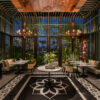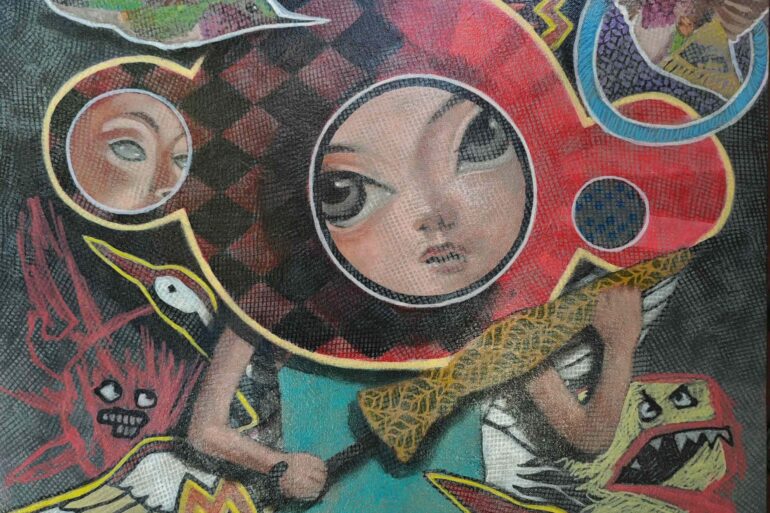A complete guide to the City of Smiles: where to stay, what to eat, what to do this weekend and beyond.
Masskara festival month is now in full swing in Bacolod. That’s a great reason to visit the City of Smiles. But if you’re wondering what else to do and enjoy aside from the grand parade that’s scheduled for Sunday, October 22, there’s plenty!
Too short a notice and can’t make it in time for this weekend’s festivities? Don’t worry. Bacolod is a great destination any time of the year, rain or shine.
Revel in the colorful masks of smiling faces to mask the darkness of sorrow, grief, and anger. This is why Masskara is unlike any other tourism festival in the country. It was born from a painful part of the nation’s history. Let’s get you plugged in to the history of the Masskara festival so you get a full appreciation for it.



Here’s the brief from festivalscape.com:
The festival began in 1980. It was created in the context of a series of difficulties and hardship on the island of Negros and the city of Bacolod in particular under the administration of Ferdinand Marcos.
They were struggling from a financial crisis as a result of economic mismanagement and corruption compounded by a marked decrease in the worldwide prices of sugar, of which the vast agricultural lands of Negros cultivated as a monocrop and exported in the global market.
Additionally, natural disasters caused undue suffering to the already vulnerable people. Peace and order situation was volatile due to the increasing tension from communist insurgency.
And in April, the city was engulfed in deep sorrow upon the news that the ship MV Don Juan sank to the depths of the sea in Tablas Strait minutes after it collided with an oil tanker. Many of its passengers were residents of Negros and reported missing.
The MassKara Festival was conceived to address the suffering of the people and as an expression of hope, optimism, and resilience amid challenging times.
MassKara means many faces and is derived from combining “mass,” which means a crowd or the general population, and kara from the Spanish word cara which means face. It also echoes the words maskara (Filipino) and mascara (Spanish), both of which refer to mask, the central prop of the festival. The name of the festival is credited to Ely Santiago, then president of the Arts Association of Bacolod.
Where to stay



Park Inn by Radisson Bacolod. The hotel is directly connected to a big mall (SM City Bacolod). As in, there’s a door in the hotel that opens to the mall. Centrally located in the city, Park Inn is a short stroll to the Bacolod Public Plaza and the San Sebastian Cathedral. It’s also near the port for ferries that shuttle between Bacolod and Iloilo. Only a year old, the cool, spacious, great-looking IG-worthy hotel is highly rated in travel sites by local and foreign guests.
Mambukal Resort. A sprawling complex with several swimming pools and a couple of therapeutic Japanese-style onsens with warm and hot water. The best thing about Mambukal Resort, however, may be its location — at the foot of the Mount Kanla-on active volcano.
Where to dine



There’s more to Bacolod than chicken inasal. There’s actually so much more! You can have breakfast, lunch, dinner, and snacks in between in different places over a four- or five-day stay and you’ll only have tasted just a fraction of all the gastronomic delights that Bacolod and nearby cities have to offer. Here’s a sampler.
Sir & Ma’am. This 50-year-old restaurant can be your first stop as it sits along the main road in Silay city where the airport is located. It serves homecooked ulam that includes classics such as embutido, lechon macau, and dinuguan with some twists in the recipe that make them unique, surprising, and a total knockout. They’re that good, yes, siree!
Felicia’s. Cake for dessert? This chain has almost two dozen different varieties to choose from. They include classic favorites such as Red Velvet, Carrot Cake, and Dulce de Leche and its own special creations such as Chocolate Gateau Nelusco Cake, Orange Pili Crunch Cake, Signature Chocolate Cake, and several Sans Rival flavors (Butter, Ube, Salted Caramel, Blueberry, Chocolate). Founded by three sisters and now run by second generation of the family, Felicia’s is Bacolod’s answer to Conti’s—only with more cakes.
Imay’s. Come for the mouthwatering seafood menu including a hearty slab of a fish called manumbok, stay for the decadently tasty tapa flakes and prepare to swim in some of the most delicious tummy-fillers you can feast on in Bacolod.
Lanai by Fresh Start. If it’s organic food you want, Lanai is one of the best places in Bacolod for you. It’s an IG-worthy open-air restaurant that uses herbs, plants and special ingredients found locally in Negros Occidental and grown in the owner’s own organic farm. Its menu of food and drinks is truly unique including several varieties of the classic piaya (passion fruit, peanuts, calamansi, muscovado) and its organic root beer soda which looks like a smoothie.
Punong Gary’s. Want to enjoy your farm-to-table gastronomic delights in a gorgeous Bali-like setting? Head on over to this hacienda in Silay which is the definition of healthy and refreshing. Two specific recommendations for starters at Gary’s: the Asian Salad, a mix of red and green lettuce, cucumber, carrots, singkamas, tamarind, sambal, galangal, honey, olive oil, and peanut sauce; and the Popover Trio, a combination of chicken, fish and vegetable popovers with red and green bell pepper, cucumber, tomatoes, and herbs in bechamel sauce. We’ll let you discover the rest of the menu, and the entire scenic place, for yourself.



21 Restaurant. This is one of Bacolod’s iconic restaurants. It’s been around since the 1980s and its popularity is rooted in its own Bacolodnon twist to the classic batchoy, a favorite merienda of Ilonggos and Negrenses. It’s filling and tasty but not heavy in the tummy. Best paired with 21 Restaurant’s equally delicious pineapple-flavored iced tea.
Bob’s Cafe. This is a chain of cafes in Bacolod. The biggest and coolest one sits right across 21 Restaurant. Aside from cakes, pastries, and coffee, it also serves pasta, pizza, and other drinks. There’s also a big deli shop, which is only one of a handful in Bacolod. This particular Bob’s Cafe pops.
Rosè Franz. A post in its Facebook page carries this caption: “Sip, Savor, and Swoon Over the Sparkle!” It’s a perfect invite from this gorgeous less than a year-old Italian restaurant that boasts a big selection of wines including its own Rosé Franz Sparkling Wine that goes down easily on the budget as it does on the taste buds.
Where to go



The Ruins. You’ve probably seen photos and videos of these ruins of a stately two-level ancestral mansion in Talisay, just outside Bacolod. It’s even more magnificent in person, especially at night when all the lights are on. It was built in the early 1900s in memory of the owner’s Portuguese wife, who died giving birth to their 8th child. That’s the reason it’s considered the Taj Majal of the Philippines. During the Second World War, Filipino guerillas burned it down as a countermeasure to prevent the invading Japanese forces from using it as a military headquarters. It burned for three days but because of the special imported cement used, pretty much the entire shell of the structure remained intact and still standing to this day.
The Art District. It’s the only one in the entire country and it’s not just one or two small galleries but a huge complex that houses a big 2-storey art gallery called The Orange Project, a micro-cinema, an art work station that’s also a warehouse, a venue for months-long artist residencies, a tattoo shop, and a cafè. Don’t worry if you’re not a fan of fine art: there’s a lot of incredible pop art to enjoy including a big carabao installation piece looking as though an actual animal is defying gravity and walking upright high up on the side of a building.
Silay Heritage Houses. Silay has the distinction of having the most government-recognized Spanish-to-American-era heritage houses in any city in all of the Philippines. Many of them are open to the public as historical museums, some boasting original, or at least authentic, furniture that give a glimpse of Filipino homes in those times. Guided tours in these houses provide brief lessons in the nation’s colonial history and, in some, include colorful, even sordid tales of personal family drama that put teleseryes to shame.
Lakawon Island. This white sand island is one of the most popular beach destinations in all of Negros. That’s probably because of its proximity to Bacolod: it’s only a little over an hour away. One of its best features is the very long wharf that welcomes guests with a picturesque view of the island.
ANP Showroom and TLDC Center. ANP stands for Association of Negros Producers, a non-government organization of micro, small, and medium enterprises (MSMEs) in Negros Occidental. TLDC is the local government’s Technology and Livelihood Development Center that helps Negrense MSMEs and people’s organizations across the province with product development and marketing. The Showroom and Center give tourists an excellent sampler of Negrense products, from handicrafts and clothing to food and drinks. These shops are the best places to buy local. And there are lots of them including unique stuff you can only buy in Bacolod.








